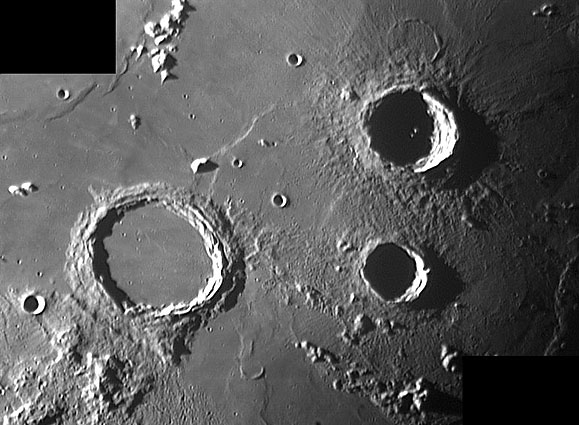64 lunar craters have names than begin with the letter A. Three of them are shown here: Archimedes (diameter = 83 km; depth = 2.1 km), Autolycus (39 km; 3.4 km) and Aristillus (55 km; 3.6 km). The latter two craters are similar in morphology and in age. Note their radiating ejecta ridges crossing the maria - and high sun images show a ray system for Aristillus and a much fainter one for Autolycus. According to the USGS system, both are Copernican, that is they are among the youngest large craters on the Moon. Unfortunately, we don't know their absolute ages. The Imbrium lavas they excavated into have an age of about 3.25 billion years. Clearly, Archimedes is older than that because it doesn't have ejecta on the Imbrium lavas - in fact, the lavas surround Archimedes. Rocks collected by Apollo 15 astronauts at nearby Hadley Rille show that significant shock events happened at 2.1 b.y. and 1.29 b.y. ago. Since there are no other young craters around, it is widely interpreted/speculated that Autolycus formed at 2.1 b.y. and Aristillus at 1.29 b.y. If true, the 800 m.y. gap between those to craters is much larger than the time since creatures first crawled out of the seas on Earth (550 m.y. ago). The Earth has changed immensely since then, the Moon, hardly at all.
Technical Details:
Celestron 11 inch SCT mounted on a Losamady G11, using an Astrovid 2000 camera on Sept 20, 2000.
More than 200+ stacked images. Two images were combined to make this picture. Mouse over for
feature names.
Related Links:
Craig's Video Astronomy
Lunar Orbiter 4 View
Full Moon View
|
Yanvar' Fevral' Mart Aprel' Mai Iyun' Iyul' Avgust Sentyabr' Oktyabr' Noyabr' Dekabr' |
|
Publikacii s klyuchevymi slovami:
Moon - Luna - Lunar Photo of the Day - LPOD
Publikacii so slovami: Moon - Luna - Lunar Photo of the Day - LPOD | |
Sm. takzhe:
Vse publikacii na tu zhe temu >> | |
